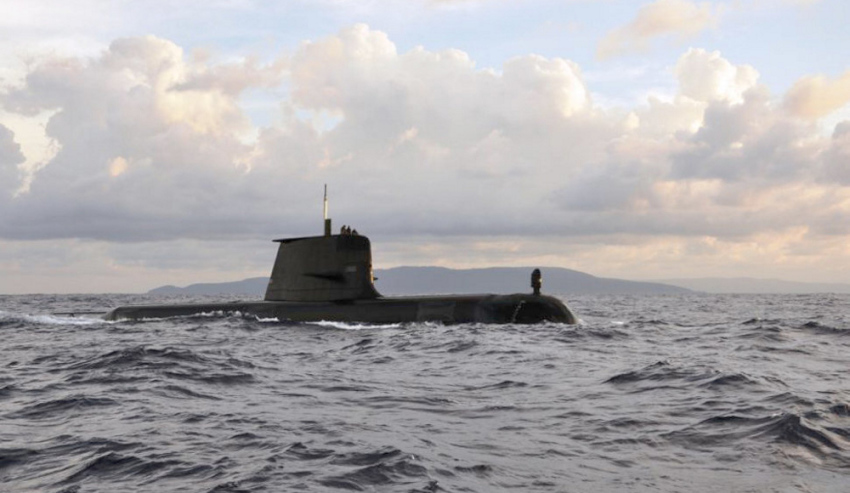Defence Minister, Linda Reynolds CSC and Defence Industry Minister, Melissa Price have announced a multi-million dollar contract with Thales Australia to provide significant sonar upgrades to the Royal Australian Navy’s Collins-class submarine fleet.
The two contracts, worth around $23.7 million, are for the design and implementation of the Mine and Obstacle Avoidance System and the High-Frequency Intercept Array for the submarine fleet.
The upgrades will not only enhance the capability of the Collins Class fleet but will provide a boost to Australian Defence industry and support Australian jobs.
Defence Minister, Linda Reynolds CSC said both the Mine and Obstacle Avoidance System and High-Frequency Intercept Array are important parts of the upgrades to the Collins sonar system.
“Our six Collins Class submarines are a highly capable and regionally superior capability that are only halfway through their operational life,. To ensure this capability maintains its edge, we are upgrading and improving its systems including through sonar upgrades,” Minister Reynolds explained.
The Heron MOAS is an Australian designed and developed system and the result of more than 20 years of investment in Australia by Thales, the RAN and Defence Science and Technology to develop sonar systems tailored to Navy’s unique operating requirements.
Mine and obstacle avoidance capability is critical to sustain naval operations due to the rapidly evolving threat of mines, as well as other navigational hazards in the shallow, poorly charted waters that are prevalent throughout Australia's maritime region.
The Herron system provides enhanced detection, coupled with a low false alarm rate, against dangers ranging from small mine-like objects to reefs, shoals, and hazardous objects like displaced shipping containers.
Minister Reynolds added, “The purpose of a Mine and Obstacle Avoidance System is to acoustically detect obstacles, including mines, which pose a threat to the submarine. The High Frequency Intercept Array detects high frequency noises including sonar transmissions.”
“With more than 20 years of investment in Australia by Thales and Defence, these upgrades will complement broader improvements to the sonar capability of the Collins Class, ensuring the regional superiority of the fleet into the future,” Minister Reynolds said.
Minister for Defence Industry Melissa Price said Thales had extensive experience working on the Collins fleet and other Australian-based companies would be engaged throughout the contracts.
“These contracts will include about 80 per cent of work being completed by Australian industry. We can expect these contracts to support 30 new jobs with Thales Australia in Rydalmere, NSW and additional jobs along the supply chain – jobs that will continue throughout the contracts,” Minister Price said.
NSW Minister for Jobs, Investment, Tourism and Western Sydney, Stuart Ayres said, “Thales Australia has a long history of supporting the Royal Australian Navy with sonars, periscopes and other electronic systems proven with the fleet at sea.
“The sonar systems developed by Thales Australia represents a major contribution to an enduring sovereign sonar capability for the nation.”
Thales Australia Underwater Systems Vice President, Troy Stephen explained the Heron MOAS will give our submarines the tools they need to remain safe within a mine threat area.
“These advanced systems are designed, developed, integrated and sustained in Australia. Enhancing our world-leading sovereign industrial capability in sonar systems. Together, these contracts will support approximately 30 jobs at our Rydalmere site in western Sydney and additional jobs with our supply chain partners,” Mr Stephen added.
Designed to be as quiet as advanced technology can achieve, Collins Class submarines have been developed from five generations of submarines designed and built by the Swedish Navy.
One of the first submarines to be totally designed by computers, these submarines boast a vast range of features. They include a high-performance hull form, highly automated controls, low indiscretion rates, high shock resistance and an efficient weapons handling and discharge system.
The submarine will move silently on electric power supplied by banks of new-technology batteries. The batteries are charged by three on-board diesel generator sets.
The sophisticated combat system, which gathers its intelligence from its sensors, computes the input and then launches and directs weapons, is an advance on any system currently available.
Each boat has been named after a distinguished former member of the RAN, some of whom have made the ultimate sacrifice for their country.
Based at Fleet Base West in Western Australia, they are a formidable element in Australia's defence capability.
Thales Australia is a trusted partner of the Australian Defence Force and is also present in commercial sectors ranging from air traffic management and ground transport systems to security systems and services.
Thales Australia employs around 3,800 people directly and supports over 1,700 job along its Australian supply chain. In 2019 Thales Australia spent $522 million with 1,362 Australia suppliers, of which 70 per cent are SMEs.
Thales Australia has a history of patient investment to build advanced in-country capability across manufacturing, critical systems and services. Close collaborative relationships with local customers, Australian SME suppliers and research institutions combined with technology transfer from our global business enables Thales to tailor high-quality solutions for Australian and export markets, generating revenue of $1.6 billion in exports over the past 10 years.






